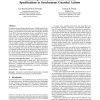717 search results - page 35 / 144 » Kill-safe synchronization abstractions |
ISCAS
2006
IEEE
14 years 5 months ago
2006
IEEE
Abstract—We present a silicon neuron that uses shunting inhibition (conductance-based) with a synaptic rise-time to achieve synchrony. Synaptic rise-time promotes synchrony by de...
LCTRTS
2010
Springer
13 years 8 months ago
2010
Springer
Concurrent Action-Oriented Specifications (CAOS) model the behavior of a synchronous hardware circuit as asynchronous guarded at an abstraction level higher than the Register Tran...
PODC
2009
ACM
14 years 11 months ago
2009
ACM
d Abstract] Christoph Lenzen Computer Engineering and Networks Laboratory (TIK) ETH Zurich, 8092 Zurich, Switzerland lenzen@tik.ee.ethz.ch Thomas Locher Computer Engineering and N...
MPC
2010
Springer
14 years 3 months ago
2010
Springer
Synchronous functional languages such as Lustre or Lucid Synchrone define a restricted class of Kahn Process Networks which can be executed with no buffer. Every expression is as...
EMSOFT
2001
Springer
14 years 3 months ago
2001
Springer
Abstract This paper is sort of a confession. Issues of synchrony, asynchrony, and synchronization, arise frequently in designing embedded systems from components, like everyone I k...


